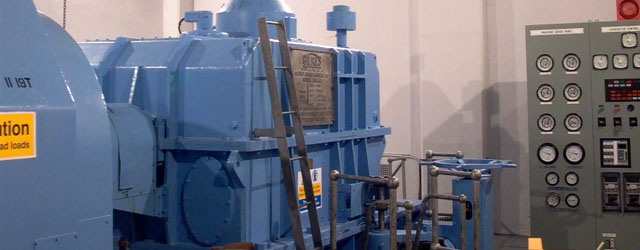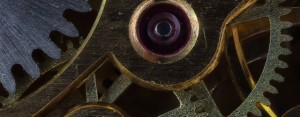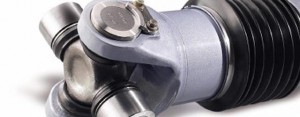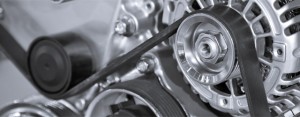 The use of a vibration condition monitoring system for monitoring vibration from large rotating machines fitted with fluid-filled journal bearings such as steam or gas turbines is well understood. Vibration from these components generally falls within the main harmonics or orders of the shaft rotational speed such as 1st, 2nd 3rd or 4th harmonic. Some energy may also exist below the 1st order, called the sub-synchronous component. Most energy exists below 1KHz and so standard displacement probes or velocity transducers are generally fitted. The Prosig PROTOR system collects this data in amplitude and phase form, relative to a ‘once-per-revolution’ phase reference signal, as standard and allows data to be displayed in real-time as mimic diagrams, trend plots, orbit and vector displays.
The use of a vibration condition monitoring system for monitoring vibration from large rotating machines fitted with fluid-filled journal bearings such as steam or gas turbines is well understood. Vibration from these components generally falls within the main harmonics or orders of the shaft rotational speed such as 1st, 2nd 3rd or 4th harmonic. Some energy may also exist below the 1st order, called the sub-synchronous component. Most energy exists below 1KHz and so standard displacement probes or velocity transducers are generally fitted. The Prosig PROTOR system collects this data in amplitude and phase form, relative to a ‘once-per-revolution’ phase reference signal, as standard and allows data to be displayed in real-time as mimic diagrams, trend plots, orbit and vector displays.
Less well known is the PROTOR system’s ability to effectively monitor auxiliary items of plant such as pumps or fans. This includes rotating machines with gearboxes, rolling-element bearings, impellers and dual shaft machines. For these types of machine the vibration spectra may contain information over a wide range of frequencies that may be related to gear-mesh frequencies for gearboxes or inner or outer race frequencies for rolling element bearings. The following features are provided as standard within PROTOR and the PROTOR hardware for auxiliary plant item monitoring is exactly the same as that used for main turbines and so standard spares cover all items.
High frequency analysis
One major difference when monitoring vibration information for some auxiliary items compared with standard steam or gas turbines is the ability to monitor high-frequency content. As mentioned above, for turbines most vibration information is within the 0 to 1KHz frequency band. For high-speed auxiliary machines with gearboxes or rolling-element bearings then some frequency components may be much higher, possibly up to 10KHz. For these machines accelerometers will generally be fitted. The PROTOR P4700 system supports accelerometers as standard and will also provide a constant-current source for IEPE transducers under software control. The P4700 system contains a programmable low-pass filter and allows sampling in excess of 20K samples per second per channel.
Multi-machine configuration
One main advantage of the PROTOR system for this type of analysis is the flexibility of the system hardware and configuration. A number of auxiliary plant equipment such as boiler feed pumps or FD and ID fans contain components running at different speeds such as a motor and a pump or a motor and a fan. A PROTOR P4700 data acquisition unit can take in up to four separate ‘once per revolution’ speed or phase reference signals and each 8-channel data acquisition card may be associated with any one of these speed signals.
each 8-channel data acquisition card may be associated with any one of these speed signals.
In this example we have a LP and HP turbine each with their own phase reference signal. Signals from the LP and HP units are analyzed relative to their own phase reference. Signals from the gearbox are ‘shared’ and analyzed twice, once relative to the LP tacho and then relative to the HP tacho.
Spectral band analysis harmonic configuration
Another feature of the PROTOR system is the ability to configure the system to analyze and collect specific harmonics. For example, for a Gas Circulator within a nuclear power station one primary frequency component is related to the number of impeller blades, in this case 31. For this case PROTOR was configured to measure the 31st harmonic as standard. This component is then available alongside the other standard harmonics for display, trending and alarm checking.
 Spectral band analysis
Spectral band analysis
Another feature of PROTOR is the ability to configure spectral bands. These frequency bands may be set by user for a particular machine and can be set dependent on the machine configuration around particular frequencies of interest such as gear-mesh frequencies or blade-passing frequencies. This method is used when the frequency content is well known and understood. Alternatively when the frequency content is not well known, the bands may be set for general zones of interest, say a low-frequency zone (below running speed) , a running speed zone, a general vibration zone (encompassing 2nd, 3rd and 4th harmonics) and a high-frequency zone.
Gearbox ratios
PROTOR also handles situations where only a single speed or phase reference signal is available. For example, with some gearboxes a single tachometer signal positioned on one side of the box is often the only speed  reference available. In this case it is possible to define the gearbox ratio and to specify the channels associated with either side of the gearbox. For channels where the speed signal is available then normal harmonic analysis is performed. For channels on the other side of the gearbox then the speed measured by the available tachometer signal is factored by the gearbox ratio, the resultant speed is then used to determine the expected harmonic locations on this channels.
reference available. In this case it is possible to define the gearbox ratio and to specify the channels associated with either side of the gearbox. For channels where the speed signal is available then normal harmonic analysis is performed. For channels on the other side of the gearbox then the speed measured by the available tachometer signal is factored by the gearbox ratio, the resultant speed is then used to determine the expected harmonic locations on this channels.
.
Don Davies
Latest posts by Don Davies (see all)
- Strain Gauge Basics – Part 2 – Shunt Calibration - February 26, 2024
- Bearing & Gearbox Vibration Analysis Using Demodulation Techniques (Part 1) - February 23, 2024
- Strain Gauge Basics – Part 1 - February 9, 2024






We use in the aircraft electric Laboratory an electric drivers system generator in order to test the aircraft electrical apparatus on ground.
We have the necessity to monitoring on line the vibrations level and in the same time to have an allarm detector previousely setted.
Thank you for the information, this was really helpful, especially the multi-machine configuration section helped a lot.